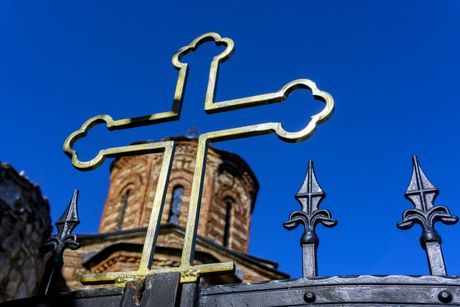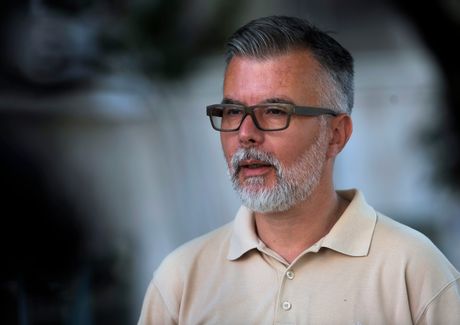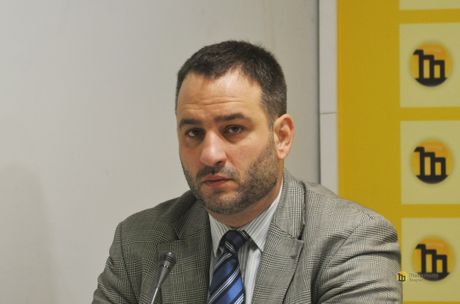"Serb arguments against Albanian force": Attempts to hijack Orthodox shrines in Kosovo and Metohija
Claims that Orthodox monasteries and churches from the era of the Serbian medieval Nemanjic dynasty do not belong to Serbia, but represent alleged "ancient Albanian heritage" are not the first attempt by Albanians to appropriate and falsify history - but experts say they have now entered a "more dangerous phase"

An article recently published by Pristina based Koha newspaper, which claims without hesitation that medieval monasteries of the Serbian Orthodox Church in Kosovo are "ancient for both indigenous Albanians, and for Serbs, who have occupied Kosovo," has caused public outrage.
During the last decades, some Albanians have been actively attacking Serbian cultural heritage in the area of the southern Serbian province, especially spiritual heritage. The culmination of the physical desecration happened at the end of March 2004, when dozens of medieval and newer-era monasteries were destroyed in just one day.
Claims that Orthodox monasteries and churches from the era of the Serbian medieval Nemanjic dynasty do not belong to Serbia, but represent alleged "ancient Albanian heritage" are not the first attempt by Albanians to appropriate and falsify history - but experts say they have now entered a "more dangerous phase."
Historian Dejan Ristic agrees with that, explaining that everything that is materially damaged can be restored to a certain extent, but if identity of a cultural good is changed, that is permanently taken away.
"There are more than 1,300 units of immovable cultural heritage in Kosovo and Metohija, mostly medieval... the Serbian Orthodox Monastery Gracanica, the Serbian Orthodox Monastery Decani, the Serbian Church of Our Lady of Ljevis and many others, so the identity is clear everywhere, it's Serbian, and Orthodox. If the identity determinant 'Serbian' is removed, then this heritage can become someone else's, although it can also remain Orthodox. And what my 'colleagues', hired by the provisional Pristina authorities and the Albanian government persistently claim is that these are not Orthodox or Serbian monuments, but Albanian or Byzantine, so they can be anyone's - but no longer Serbian," Ristic told our portal.

He stressed out that material evidence and written sources undoubtedly testify to the fact that specific cultural goods in the area of Kosovo and Metohija are exclusively a part of the Serbian cultural heritage.
Ristic says that one should have a highly developed awareness of what cultural heritage represents and that it is at the same time identity heritage, meaning, among other things, that it's a first-class security issue.
"When you remove one population or most of it, what follows is the removal of material traces of that people, and after that you have nothing. You don't have members of that nation or you have them at the level of statistical error, while on the other hand you have completely eliminated any material traces, i.e., the immovable, movable or intangible cultural heritage of that people. And after that, the whole process, unfortunately, is permanently over," he explains.
How to protect the shrines until a final agreement?
Igor Novakovic from the Center for International and Security Affairs says that although Serbia does not recognize the Ahtisaari plan, that still establishes certain protection systems and the international community can insist on a consistent application of all the elements.
"The international community can certainly appeal on Pristina to try to influence making the tone of the public discourse neutral regarding the attempt to appropriate Serb shrines," he said.

He also noted that this issue should be back on the negotiating table in Brussels.
In addition, a recent agreement singed at the White House between Belgrade and Pristina states that court decisions related to the return of the Serbian Orthodox Church (SPC) property must be respected, which means that all verdicts that prove that property belongs to the Serbian Church must be respected.
In this regard, Novkovic recalled that both sides have committed in the political sense, but that a supervisory mechanism and a whole range of other elements that characterize an international agreement are missing.
"In that sense, it is not a legal obligation, but a political one. However, in this case, the influence of the US could be significant because they are also the sponsor of the signed document," he told Telegraf.rs.
The United States has shown that it can decisively influence political processes in Kosovo and Metohija, and the Albanian parties will probably keep that in mind, analysts believe. However, the degree to which the signed agreements will be respected will depend only on America's stance.
How to oppose Albanian attempts at appropriation?
Historian Ristic recalled that four sites in the area of the southern Serbian province are also under UNESCO protection, which means this is at the same time Serbian, but also European and world heritage.
"Cultural heritage should bring people together instead dividing them, and here we have a situation where cultural heritage becomes a first-class security and political issue that is used to create clear divisions, to draw a historically lasting line between Serbs who are indigenous and have lived in Kosovo and Metohija for centuries, and Albanians who came to that area much later, several centuries later, compared to us," he said and added that Albanians use the argument of force, while the Serbian side has the force of arguments on its side.
Strong reactions from Belgrade, silence in Pristina
Director of the Office for Kosovo and Metohija Marko Djuric said that Serb children have sent the strongest message about to whom Orthodox shrines in Kosovo and Metohija belong.
"Serb children from Kosovo Pomoravlje gave the strongest answer to whom Orthodox shrines in Kosovo and Metohija belong. The Serb nation has gone through numerous Golgothas throughout history, but no one has ever managed to take away its soul," said the director of the Office for Kosovo and Metohija, Marko Djuric.
Српска деца из Косовског Поморавља дала су најснажнији одговор на питање чије су православне светиње на Косову и Метохији. Српски народ је кроз историју прошао кроз бројне голготе, али никад нико није успео да му отме душу. #Србија #косовоиметохија #ким #Srbija #kosovoimetohija #kimA post shared by Марко Ђурић (@markodjuric.srb) onView this post on Instagram
The Ministry of Culture also issued a statement.
"Unfortunately, we are witnessing another provocation by Kosovo Albanian authors and the media, who are sending a clear message with this act about how the Albanian majority in Kosovo and Metohija views the position of the Serb people, their cultural heritage and the Serbian Orthodox Church in the southern Serbian province. This time as well, we appeal on the international community and organizations to approach the protection of the Serb cultural heritage with the utmost attention, which is their obligation, confirmed by earlier and recently signed agreements," the statement said.
For now, there has been no reaction from Pristina, nor have there been dissonant voices in Albanian media.
The Diocese of Raska and Prizren of the SPC points out that Albanian authors see the shrines of the Serbian Orthodox Church as the biggest obstacle to the realization of the idea of an ethnically pure, Albanian Kosovo.
The Diocese once again recalls and asks why no Albanian historian from Kosovo is capable of explaining why Albanian extremists destroyed churches and monasteries so ruthlessly, if they belong to them - why they ripped out crosses, dug up Christian graves, desecrated crucifixes and icons?
Video: Works have stopped around Visoki Decani, but fears remain
(Telegraf.rs)
Telegraf.rs zadržava sva prava nad sadržajem. Za preuzimanje sadržaja pogledajte uputstva na stranici Uslovi korišćenja.




